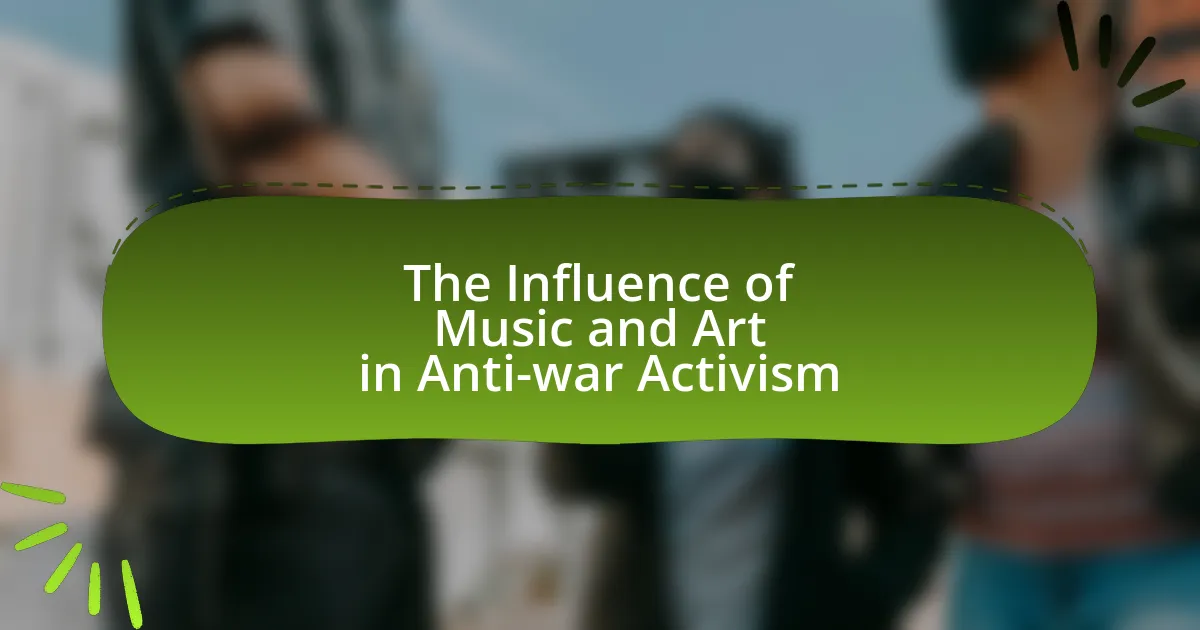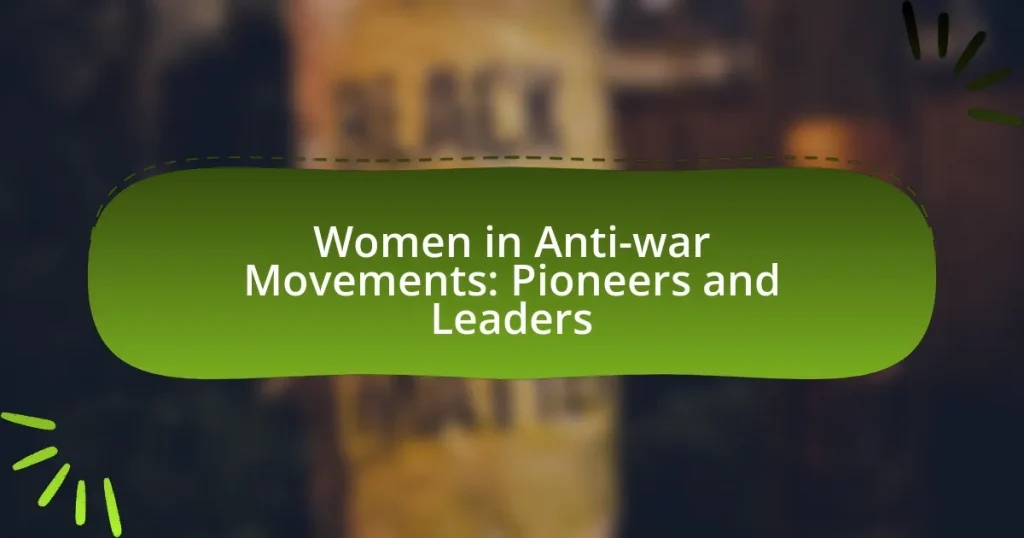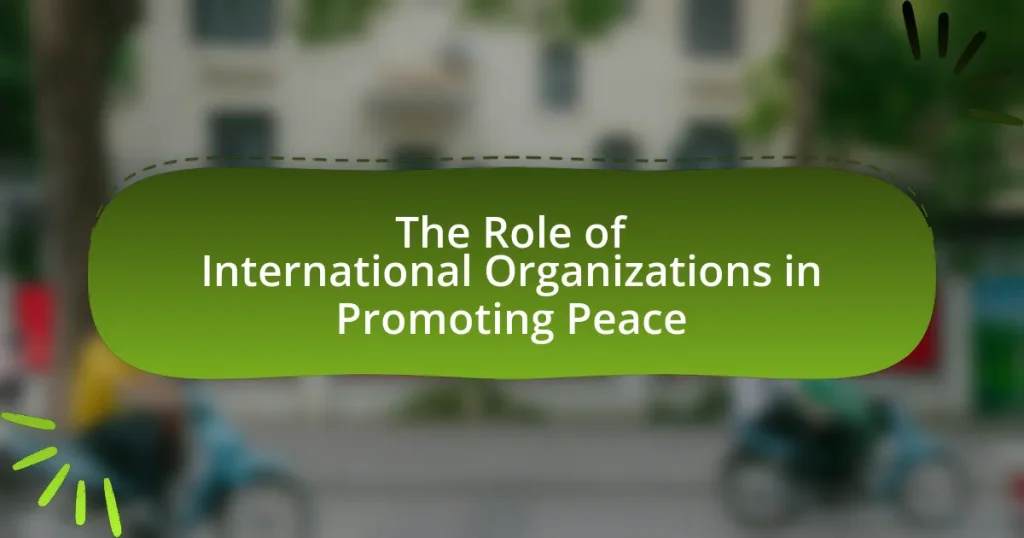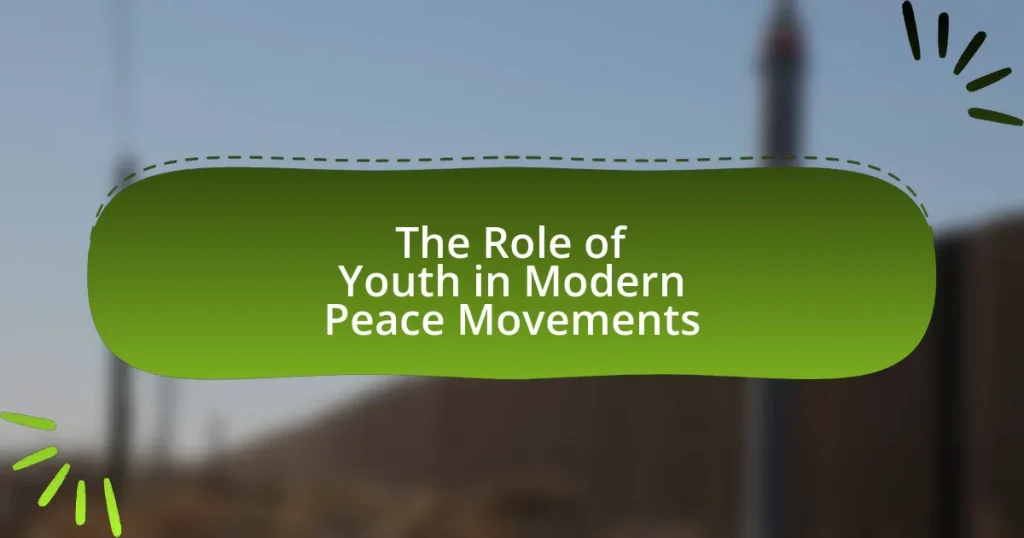The article examines the significant influence of music and art in anti-war activism, highlighting their roles as tools for expression, mobilization, and emotional engagement. It discusses historical examples, such as protest songs from the Vietnam War era and iconic artworks like Picasso’s “Guernica,” which have shaped public sentiment against war. The article also explores how contemporary artists and musicians can engage in anti-war efforts today, the psychological effects of artistic expression on audiences, and the importance of collaboration between artists and activists in promoting peace. Key movements and initiatives that have utilized music and art for anti-war purposes are also outlined, providing a comprehensive overview of the intersection between creativity and activism in the context of war.
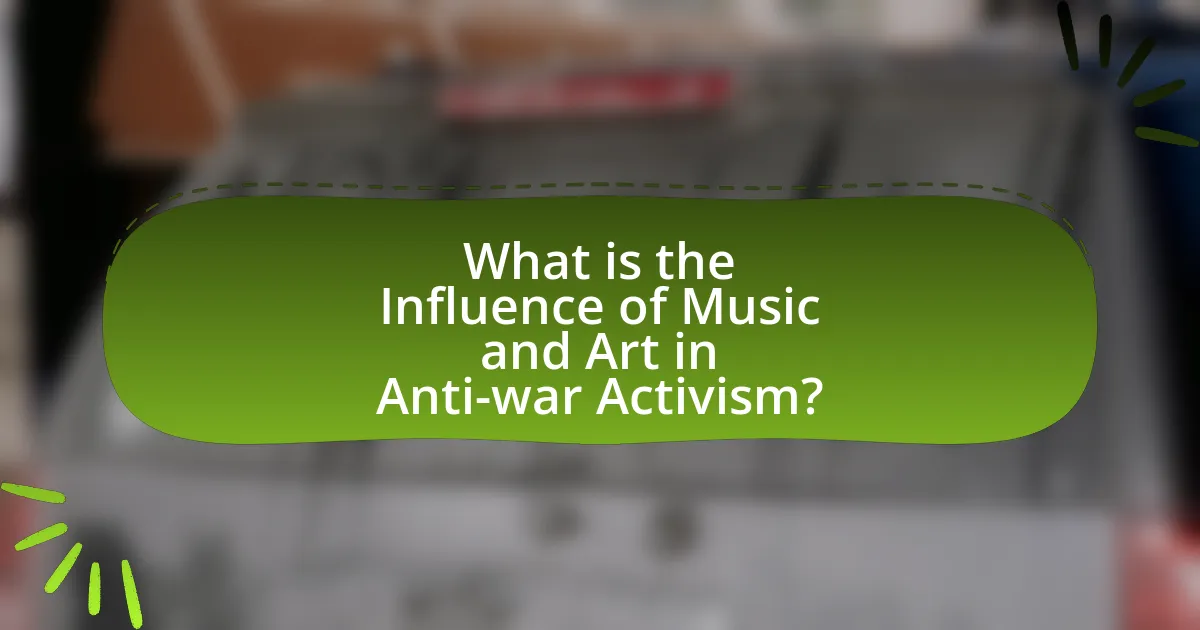
What is the Influence of Music and Art in Anti-war Activism?
Music and art significantly influence anti-war activism by serving as powerful tools for expression and mobilization. They evoke emotional responses, raise awareness, and foster solidarity among activists. Historical examples include the protest songs of the 1960s, such as Bob Dylan’s “Blowin’ in the Wind,” which questioned war policies and inspired a generation to advocate for peace. Additionally, visual art, like Picasso’s “Guernica,” powerfully depicted the horrors of war, galvanizing public sentiment against violence. These artistic expressions not only communicate anti-war messages but also create a shared cultural narrative that unites individuals in their opposition to conflict.
How has music historically contributed to anti-war movements?
Music has historically contributed to anti-war movements by serving as a powerful tool for expression and mobilization. During the Vietnam War, for example, songs like “Fortunate Son” by Creedence Clearwater Revival and “Give Peace a Chance” by John Lennon became anthems for the anti-war movement, articulating public dissent and galvanizing protests. These songs resonated with widespread sentiments against the war, effectively uniting individuals and communities in their opposition. Additionally, music festivals, such as Woodstock in 1969, provided a platform for artists to voice their anti-war messages, further amplifying the movement’s reach and impact. The emotional and cultural significance of music has consistently played a crucial role in shaping public opinion and fostering solidarity among activists throughout history.
What are some iconic songs associated with anti-war activism?
Iconic songs associated with anti-war activism include “Fortunate Son” by Creedence Clearwater Revival, “Give Peace a Chance” by John Lennon, and “Blowin’ in the Wind” by Bob Dylan. “Fortunate Son,” released in 1969, critiques the privilege of those who evade the draft, resonating with the sentiments of the Vietnam War protests. John Lennon’s “Give Peace a Chance,” released in 1969, became an anthem for the peace movement, emphasizing the call for non-violence. Bob Dylan’s “Blowin’ in the Wind,” released in 1963, poses rhetorical questions about peace and freedom, capturing the essence of the civil rights and anti-war movements. These songs played significant roles in shaping public opinion and mobilizing activism against war.
How do lyrics in protest songs convey anti-war messages?
Lyrics in protest songs convey anti-war messages by using powerful imagery, emotional appeals, and direct criticism of war policies. These songs often highlight the human cost of conflict, portraying the suffering of soldiers and civilians alike, which evokes empathy and encourages listeners to question the morality of war. For example, Bob Dylan’s “Blowin’ in the Wind” poses rhetorical questions about peace and justice, prompting reflection on societal values. Additionally, songs like “Fortunate Son” by Creedence Clearwater Revival critique the disparity between those who are sent to fight and those who evade the consequences of war, reinforcing the message that war disproportionately affects the less privileged. Through these lyrical strategies, protest songs effectively mobilize public sentiment against war and inspire activism.
In what ways has visual art played a role in anti-war activism?
Visual art has played a significant role in anti-war activism by serving as a powerful medium for expression and communication of dissent. Artists have utilized various forms of visual art, such as paintings, posters, and installations, to convey the emotional and social impacts of war, thereby raising public awareness and fostering critical dialogue. For instance, Pablo Picasso’s “Guernica” vividly depicts the horrors of war and has become an iconic symbol of anti-war sentiment, illustrating the suffering caused by conflict. Additionally, the Vietnam War era saw the proliferation of protest posters and street art that challenged governmental narratives and mobilized public opposition, exemplified by works from artists like Robert Rauschenberg and the use of silk-screen printing techniques. These artistic expressions not only captured the zeitgeist of their respective eras but also inspired collective action and solidarity among anti-war movements, demonstrating the profound influence of visual art in shaping public perception and activism against war.
What are notable artworks that depict anti-war sentiments?
Notable artworks that depict anti-war sentiments include Pablo Picasso’s “Guernica,” which powerfully illustrates the horrors of war and the suffering it inflicts on civilians, specifically in response to the bombing of Guernica during the Spanish Civil War. Another significant piece is Otto Dix’s “The War,” which starkly portrays the brutal realities of World War I and its impact on soldiers. Additionally, Kathe Kollwitz’s “The Weavers” and “The Grieving Parents” express deep sorrow and loss due to war, highlighting the emotional toll on families. These artworks serve as poignant critiques of war, reflecting the artists’ responses to the violence and devastation they witnessed.
How do artists use symbolism to express anti-war themes?
Artists use symbolism to express anti-war themes by employing visual metaphors and imagery that convey the horrors and futility of war. For instance, Pablo Picasso’s “Guernica” uses distorted figures and monochromatic tones to symbolize the suffering caused by the Spanish Civil War, effectively communicating the chaos and devastation of conflict. Similarly, the use of doves, broken weapons, and barren landscapes in various artworks serves as powerful symbols of peace and the loss associated with war. These symbols resonate emotionally with audiences, making the anti-war message more impactful and memorable.
Why is the combination of music and art effective in anti-war activism?
The combination of music and art is effective in anti-war activism because it evokes emotional responses and fosters community engagement. Music can convey powerful messages and resonate with individuals on a personal level, as seen in protest songs like “Give Peace a Chance” by John Lennon, which became an anthem for the anti-war movement in the 1960s. Art, such as visual installations or graffiti, can visually represent the horrors of war, making the impact more immediate and relatable. For instance, Pablo Picasso’s “Guernica” powerfully depicts the suffering caused by war, influencing public perception and sparking dialogue. Together, music and art create a multifaceted approach that not only raises awareness but also mobilizes individuals to take action against war.
How do music and art together amplify the message of peace?
Music and art together amplify the message of peace by creating a universal language that transcends cultural and linguistic barriers. This synergy fosters emotional connections and collective experiences, enabling individuals to resonate with the ideals of peace. For instance, events like the “Woodstock Festival” in 1969 showcased how music and visual art combined to promote anti-war sentiments, drawing hundreds of thousands together in a shared vision of harmony. Additionally, studies have shown that music can evoke strong emotional responses, while visual art can provoke thought and reflection, making them powerful tools in conveying messages of peace and unity.
What psychological effects do music and art have on audiences in the context of anti-war activism?
Music and art evoke strong emotional responses in audiences, significantly influencing perceptions and attitudes toward anti-war activism. These mediums can foster empathy, raise awareness, and mobilize collective action by conveying the human cost of war through powerful imagery and poignant lyrics. For instance, songs like “Fortunate Son” by Creedence Clearwater Revival and artworks like Picasso’s “Guernica” have historically galvanized public sentiment against conflict, illustrating the psychological impact of artistic expression in shaping anti-war narratives. Research indicates that exposure to emotionally charged art can enhance feelings of solidarity and motivate individuals to engage in activism, demonstrating the profound psychological effects of music and art in this context.
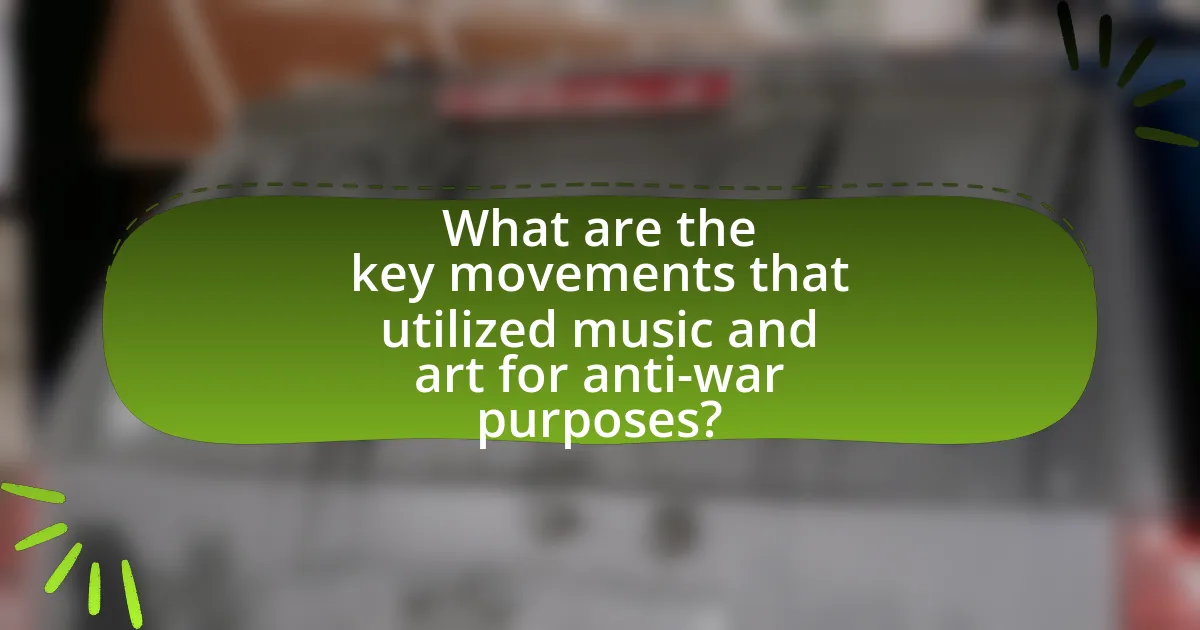
What are the key movements that utilized music and art for anti-war purposes?
The key movements that utilized music and art for anti-war purposes include the Vietnam War protests, the Civil Rights Movement, and the anti-nuclear movement. During the Vietnam War protests, artists and musicians like Joan Baez and Bob Dylan created powerful songs that highlighted the horrors of war and called for peace, influencing public opinion against U.S. involvement in Vietnam. The Civil Rights Movement also employed music, with songs like “We Shall Overcome” serving as anthems for social justice and anti-war sentiments. Additionally, the anti-nuclear movement in the 1980s saw artists like Pete Seeger and various punk bands use their platforms to advocate against nuclear weapons, emphasizing the dangers of militarization through art and music. These movements collectively demonstrate the significant role that creative expression played in shaping anti-war activism.
How did the Vietnam War influence music and art activism?
The Vietnam War significantly influenced music and art activism by serving as a catalyst for social and political expression. Artists and musicians responded to the war’s brutality and the anti-war sentiment it generated, creating works that critiqued U.S. involvement and advocated for peace. For instance, songs like “Fortunate Son” by Creedence Clearwater Revival and “Give Peace a Chance” by John Lennon became anthems of the anti-war movement, reflecting widespread public discontent. Additionally, visual artists used mediums such as posters and paintings to convey powerful messages against the war, exemplified by the iconic “Peace” symbol and protest art that emerged during this period. This artistic activism not only galvanized public opinion but also played a crucial role in shaping the cultural landscape of the 1960s and 1970s, demonstrating the profound impact of the Vietnam War on creative expression.
What role did folk music play during the Vietnam War protests?
Folk music served as a powerful tool for expression and mobilization during the Vietnam War protests. It provided a means for activists to convey their anti-war sentiments, unify diverse groups, and inspire collective action. Iconic songs like “Blowin’ in the Wind” by Bob Dylan and “Where Have All the Flowers Gone” by Pete Seeger became anthems of the movement, articulating the frustrations and hopes of a generation opposed to the war. These songs not only resonated emotionally with listeners but also helped to galvanize public opinion against U.S. involvement in Vietnam, contributing to the broader anti-war narrative. The widespread performance of folk music at rallies and protests reinforced solidarity among demonstrators and amplified their message, making it a crucial element of the anti-war activism landscape during that era.
How did visual artists respond to the Vietnam War through their work?
Visual artists responded to the Vietnam War by creating powerful works that conveyed the horrors of war and the anti-war sentiment prevalent during that era. Artists like Andy Warhol and Robert Rauschenberg used their platforms to critique the war, with Warhol’s “Death and Disaster” series highlighting the violence and chaos associated with the conflict. Additionally, the Vietnam Veterans Memorial, designed by Maya Lin, serves as a poignant reminder of the war’s impact, honoring those who served while also prompting reflection on the consequences of military action. These artistic expressions not only documented the emotional and physical toll of the Vietnam War but also galvanized public opinion against it, illustrating the significant role of visual art in anti-war activism.
What impact did the anti-nuclear movement have on music and art?
The anti-nuclear movement significantly influenced music and art by serving as a catalyst for creative expression that addressed nuclear disarmament and the dangers of nuclear weapons. Artists and musicians used their platforms to raise awareness, often incorporating themes of peace, protest, and the consequences of nuclear warfare into their work. For instance, songs like “Give Peace a Chance” by John Lennon became anthems for the movement, while visual artists created powerful imagery that depicted the horrors of nuclear fallout, such as the works of Pablo Picasso and his anti-war paintings. This artistic response not only reflected societal concerns but also mobilized public opinion against nuclear proliferation, demonstrating the profound connection between activism and creative expression during this period.
Which musicians and artists were prominent in the anti-nuclear movement?
Prominent musicians and artists in the anti-nuclear movement included Joan Baez, Pete Seeger, and the band Jefferson Airplane. Joan Baez was known for her folk music and activism, often performing at anti-nuclear rallies and events. Pete Seeger, a key figure in the folk music revival, used his music to advocate for peace and nuclear disarmament, notably participating in the 1982 anti-nuclear rally in New York City, which drew over a million participants. Jefferson Airplane’s song “Volunteers” became an anthem for the counterculture movement, expressing opposition to war and nuclear weapons. These artists significantly contributed to raising awareness and mobilizing public sentiment against nuclear proliferation during the Cold War era.
How did public art installations contribute to anti-nuclear sentiments?
Public art installations significantly contributed to anti-nuclear sentiments by visually communicating the dangers and ethical implications of nuclear weapons. These installations often utilized provocative imagery and symbolism to evoke emotional responses, raising public awareness about the catastrophic consequences of nuclear warfare. For instance, the “Nuclear Family” installation by artist John McPhee in the 1980s depicted a family in a nuclear fallout shelter, highlighting the absurdity and fear surrounding nuclear preparedness. Such artworks served as powerful tools for activism, mobilizing communities and fostering dialogue about disarmament and peace.
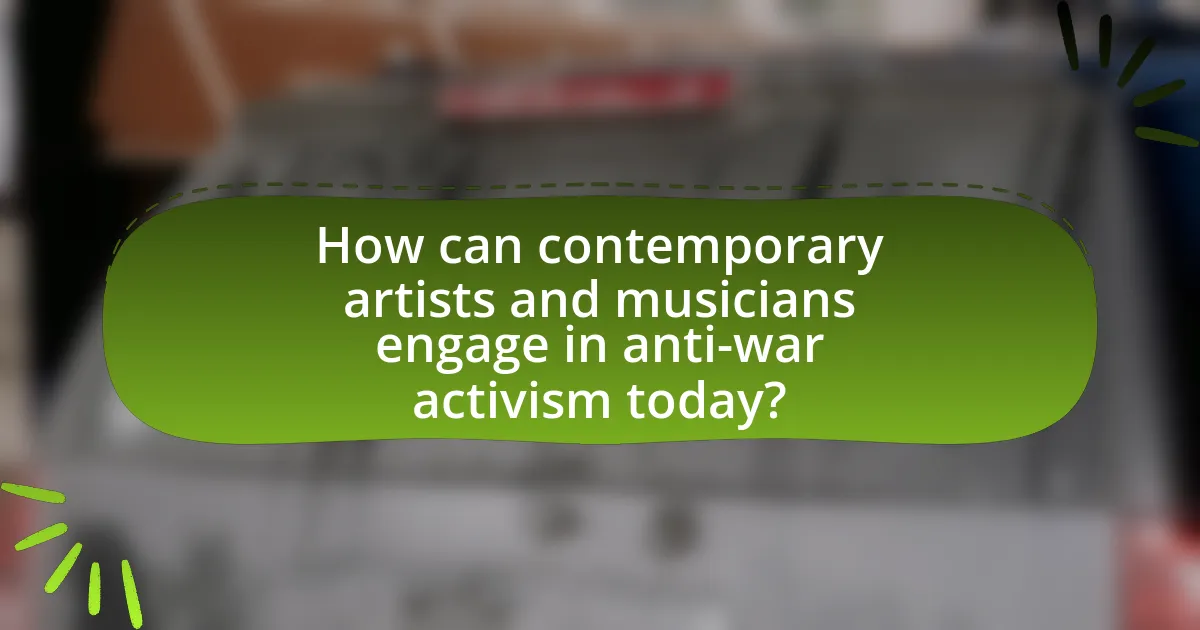
How can contemporary artists and musicians engage in anti-war activism today?
Contemporary artists and musicians can engage in anti-war activism today by creating impactful works that raise awareness about the consequences of war and promote peace. They can utilize various mediums, such as music, visual art, and performance, to convey messages that resonate with audiences, encouraging critical reflection on military conflicts. For instance, musicians like Billie Eilish and artists like Ai Weiwei have used their platforms to address social issues, including war, through lyrics and installations that highlight human suffering and advocate for humanitarian efforts. Additionally, collaborations with non-profit organizations focused on peacebuilding can amplify their messages, as seen in events like the “Artists for Peace” initiative, which unites creatives to support anti-war causes.
What strategies can modern artists use to promote peace through their work?
Modern artists can promote peace through their work by utilizing visual storytelling, collaborative projects, and social media engagement. Visual storytelling allows artists to convey powerful messages about peace and conflict, often evoking emotional responses that resonate with audiences. Collaborative projects, such as community murals or art installations, foster dialogue and unity among diverse groups, emphasizing shared values and the importance of peace. Social media engagement enables artists to reach a global audience, spreading awareness and encouraging discussions around peace initiatives. These strategies have been effective in various movements, such as the “Art for Peace” initiative, which showcases artworks that address themes of non-violence and reconciliation, demonstrating the impact of art in promoting peace.
How can social media be leveraged for anti-war art and music campaigns?
Social media can be leveraged for anti-war art and music campaigns by providing a platform for widespread dissemination and engagement with creative content that promotes peace. Artists and musicians can utilize platforms like Instagram, Twitter, and Facebook to share their work, reach diverse audiences, and foster community discussions around anti-war messages. For instance, campaigns such as “Art for Peace” have successfully used social media to organize virtual exhibitions and live performances, allowing artists to connect with supporters globally. Additionally, social media’s shareability enables viral content, amplifying the reach of anti-war messages, as seen in the #NoWar hashtag movement, which has mobilized millions to advocate against military conflicts.
What role do collaborations between artists and activists play in contemporary anti-war efforts?
Collaborations between artists and activists play a crucial role in contemporary anti-war efforts by amplifying messages, fostering community engagement, and mobilizing public opinion against conflict. Artists utilize their creative platforms to express dissent and raise awareness about the consequences of war, while activists provide the context and urgency needed to drive these messages home. For example, initiatives like the “Artists Against War” collective have successfully organized events that combine visual art, music, and performance to highlight the human cost of military actions, thereby reaching diverse audiences. This synergy not only enhances the emotional impact of anti-war narratives but also encourages collective action, as seen in campaigns that have influenced public policy and shifted societal attitudes towards military interventions.
What are some successful examples of recent anti-war music and art initiatives?
Recent successful examples of anti-war music and art initiatives include the song “Not Ready to Make Nice” by the Dixie Chicks, which critiques the Iraq War and has resonated with audiences since its release in 2006, and the “Art for Peace” project, which features various artists creating works that promote peace and raise awareness about the consequences of war. Additionally, the “Songs for Peace” compilation album, released in 2022, showcases contemporary artists addressing themes of conflict and advocating for peace through their music. These initiatives have effectively mobilized public sentiment against war and fostered dialogue on the impact of military actions.
How have festivals and events contributed to anti-war activism in recent years?
Festivals and events have significantly contributed to anti-war activism in recent years by providing platforms for artists and activists to express dissent and mobilize communities. These gatherings often feature performances, speeches, and workshops that raise awareness about the consequences of war, promote peace, and encourage civic engagement. For instance, events like the “March for Our Lives” and various music festivals have integrated anti-war messages into their programming, attracting large audiences and fostering dialogue around military conflicts. Additionally, studies have shown that participation in cultural events can enhance political engagement, as seen in research published by the American Political Science Review, which indicates that collective experiences at festivals can galvanize individuals to take action against war and militarism.
What lessons can be learned from past anti-war movements for current activism?
Past anti-war movements demonstrate the importance of grassroots organization, effective communication, and the integration of art and music to mobilize public sentiment. For instance, the Vietnam War protests utilized music, such as songs by Bob Dylan and Joan Baez, to convey anti-war messages and unify participants, illustrating how cultural expressions can amplify activism. Additionally, the Civil Rights Movement’s collaboration with anti-war efforts highlighted the intersectionality of social justice issues, showing that current activism can benefit from building coalitions across various causes. Historical data indicates that movements with strong artistic components often achieve greater visibility and emotional resonance, making it essential for contemporary activists to harness similar strategies.
What practical steps can individuals take to support anti-war music and art initiatives?
Individuals can support anti-war music and art initiatives by actively participating in and promoting events that showcase such works. This includes attending concerts, art exhibitions, and festivals that focus on anti-war themes, which helps to increase visibility and awareness. Additionally, individuals can share these events on social media platforms to reach a wider audience, thereby amplifying the message against war. Supporting artists financially through purchasing their music, art, or merchandise directly contributes to their ability to create and promote anti-war content. Furthermore, individuals can volunteer for organizations that advocate for peace through art and music, providing essential resources and support for these initiatives. Engaging in discussions about the impact of war and the role of art in activism can also foster a community that values and promotes anti-war messages.
